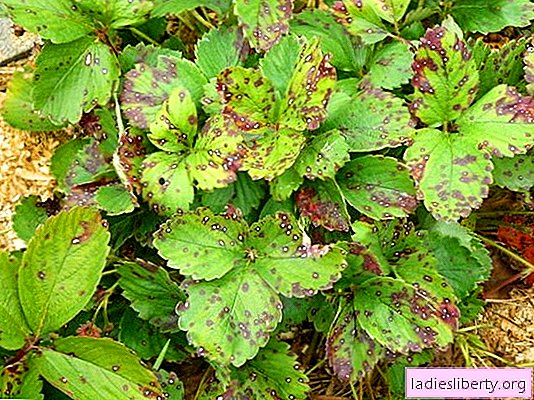
Stains on strawberry leaves are signs of damage to this plant by various fungal diseases.
Their pathogens winter on plant debris, and in the spring, with increased humidity and plus air temperatures, they begin to actively develop.
Depending on the type of pathogenic fungus and the conditions for growing strawberries, the signs of the disease and methods of controlling it differ.
Brown spots on strawberry leaves
When strawberries are affected by angular (brown) spotting, the appearance on the leaves is rounded purple spots, which then turn brown. As the disease develops, a darker border is formed on the spots, visible on the underside of the leaf. First, spots are localized at the edges of the leaf blade, gradually merging and spreading between the veins of the leaves. Their shape takes on an angular configuration, tapering to the center of the sheet. Affected tissue is necrotic. In wet weather, spore-bearing fungal pycnids form on the spots.
Brown (angular) spotting on strawberry leaves

Due to the fact that angular spotting develops in August-October, many inexperienced summer residents and gardeners take this process for the natural death of foliage before the onset of cold weather and do not take appropriate measures. This is the mistake: during this period, fruit buds are laid the next year, and the mass death of foliage weakens the plants, reduces its winter hardiness and the size of the future crop.
Rusty Stains on Strawberry Leaves
A common and dangerous disease of plants, including strawberries, is rust, the causative agent of which is a rust fungus. Signs of this disease are a variety of shapes and sizes of orange or yellow pustules ("pads") on the leaves. As the disease develops, the pads merge, forming strips of rusty color, the leaves turn yellow and fall off. When cracking, spores spill out of the pustules of the fungus. Rust contributes to increased evaporation of moisture from leaves, as a result of which nutrients and photosynthesis are disrupted, and the quality and quantity of berries deteriorate. If the first signs of rust are detected, immediate action must be taken without delaying the treatment for later. At an early stage, infected parts of strawberries must be removed and treated with fungicides (Topaz, Abiga-Peak, Fitosporin, etc.).
Rusty spots can also be the initial sign of anthracnose - a disease of fungal etiology, widespread in both southern and temperate latitudes. Anthracnose is characterized by the appearance on the leaves of small (up to 2-3 mm in diameter) rusty or red-brick colored spots with a thin darker border, which subsequently dry out. The leaf blade tissue around the spots continues to grow, so the dead areas crack and tear.
Manifestation of anthracnose on a strawberry leaf - dead tissue cracks

Leaves do not die, but are a source of infection. Therefore, at the first sign, it is important to start processing plants to prevent the spread of the disease.
Often, leaf damage begins at the edges, as moisture collects here, draining from the surface of the leaf blade. These spots have a distinct purple-burgundy border. On petioles of leaves and peduncles, anthracnose manifests itself in the form of an elongated form of dark brown ulcers. When they are ring-shaped fusion, the leaf or stem dries.
Anthracnose besides the green parts of the strawberry bush also affects berries at all stages of their development. On the ovaries, it appears in the form of pressed black spots, and on ripe berries - in the form of brown watery spots with a dry surface, immersed in the flesh of the berry. Affected ovaries and berries are mummified, becoming a source of infection.
In order not to confuse anthracnose with other types of spotting, you can conduct a simple independent diagnosis. To do this, place any infected part of the strawberries in a humid environment (for example, in a greenhouse or in a glass dish, put in a warm place). After 5-7 days, mold (fungal mycelium) will grow on the plant tissue, on which pollen spores can be seen. By its color, you can determine the type of pathogenic fungus. The causative agent of anthracnose Colletotrichum acutatum is characterized by a pinkish-orange color in various shades of saturation.
Brown spots on strawberry leaves
The appearance of brown spots on the leaves of strawberries of various shapes and sizes indicates that the plant is affected by the brown spotting pathogen. The first wave of this disease begins in April-May, and reaches its peak in July-August and leads to the death of up to 80% of the surface of leaf blades, which greatly weakens plants. First, the spots are small, on both sides of the leaves have a brownish-red color. As the disease progresses, the area of damage increases as a result of the fusion of spots, their color becomes almost black. Leaves look withered.
Brown spotting on strawberry leaves.

On the mustache and petioles of the leaves, the spots are smaller (look like pressed small dots).
The lower leaves are the first to be affected, especially if the strawberry beds are not well-groomed: thickened, clogged with weeds. Favorable conditions for the development of fungi are increased humidity, poor ventilation of strawberry leaves, warm weather.
Other parts of strawberries are also affected by brown spotting: fruits, stems, stalks, sepals. At the same time, the berries do not have time to ripen: they become small and "bony."
This disease is insidious in that at a late stage it creates the illusion of "recovery": leaves that are stunted begin to grow, spore-bearing pads disappear, and inexperienced gardeners associate dwarf shrubs with nutrient deficiencies. If the strawberry beds are not treated with fungicides during this period, then in the second half of August, brown spotting again attacks the young growing leaves.
Brown spots on strawberry leaves can be the cause of a disease such as white spotting. In the initial stage of the disease, spots of rounded shape, reaching a diameter of up to 2 mm, are brown in color. In the future, they have a burgundy border. After the middle of the spots brightens, it collapses - holes remain on the leaves.
White spotting on strawberry leaves

White spotting affects not only the leaves, but also other parts of the plant: stalks, petioles, berries. The spots in this case have an elongated elongated shape. Black dots appear on the berries near the seeds, and then the disease penetrates the soft tissues of the berries, they are covered with a dark brown skin. A massive defeat of strawberry plantings with white spotting begins in the second half of the season. Spores are scattered by the wind and raindrops, they can germinate even at + 8 ° C. Although white spotting does not lead to the death of strawberry bushes, it significantly worsens the presentation and taste of the berries.
Strawberry Stain Control Methods
For the prevention of fungal diseases of strawberries, it is important to observe the following agricultural practices:
• use healthy seedlings of varieties resistant to fungal diseases;
• grow strawberries in open, dry areas, preferably in tall or vertical beds;
• destroy plant residues of diseased plants and weeds;
• plant strawberries correctly in the beds - thickened plantings are poorly ventilated, as a result of which spores of pathogenic fungi actively develop in an environment with high humidity;
• comply with fertilizer application standards - mycelium actively develops on plants "overfed" with nitrogen;
• to combat insect pests, which are carriers of fungal spores and viral infections;
• observe crop rotation - after infection, strawberries are returned to their old place only after 4-5 years. The best predecessors for her are carrots, onions, garlic, beans, leafy salads or pure steam. It is not recommended to plant strawberries in areas after nightshade (potatoes, tomatoes, eggplant), cucumbers, corn;
• treat strawberry bushes with preparations containing copper (Phytosporin-M, copper chloroxide, 1% Bordeaux liquid, Ridomil Gold, etc.) twice a season - before flowering and after picking berries.
Save











